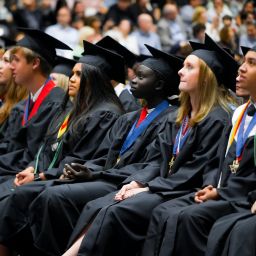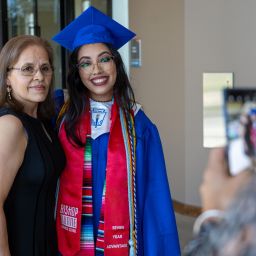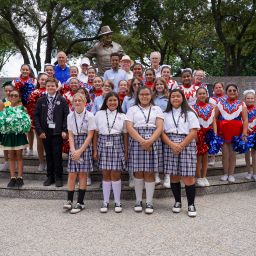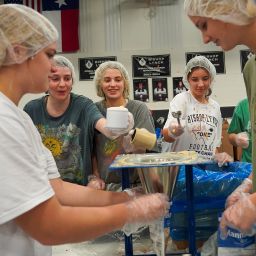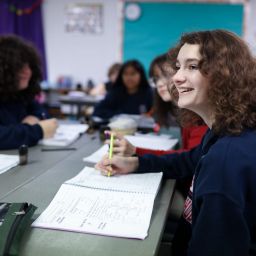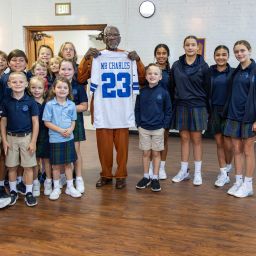
By Michael Gresham
The Texas Catholic
Middle-schoolers William Bui and John Veselka inspected their handiwork as they attempted to build a zip-line pulley. A few feet away, classmates Charlee Delaurier and Charlotte Fowler were putting the final touches on their circuitry project. A low buzz of excitement and energy spread throughout the room as the St. Monica Catholic School students joined their classmates on Sept. 29 in exploring learning opportunities at various stations in one of the school’s two new STEM (Science, Technology, Engineering and Math) labs.
“It’s so exciting and inspiring to see the students so engaged in learning,” said Angie Trudell, president of St. Monica Catholic School.
This year, the school began fully utilizing its two new labs, one for students in kindergarten through fifth grade while the other serves sixth- through eighth-graders. According to Trudell, the two STEM labs were funded by the 2021 and 2022 Bearcat Annual Fund program run, held in August and September each year. Additionally, funds were allocated from EANS (Emergency Assistance for Public Schools).
“We applied for the STEM lab specifically and were approved for these funds to use specifically for the lab,” Trudell explained. “We continue to raise funds through grants to maintain our labs.”
The lower-school STEM lab first became available to students this school year. The upper-school STEM lab was made available to middle-school students at the end of the 2021-2022 school year.
Kelsie McHale serves as the STEM facilitator for the elementary lab while Will Vincent serves as the STEM facilitator for fifth through eighth grade. The main difference between the two labs is the difficulty and length of the projects and the amount of instruction given to the students, according to Vincent.
“In the lower-level STEM lab, class projects can range from one day to three or more days often with instruction from the facilitator,” he said. “In the upper-school STEM lab, all projects last seven days, and students are not walked through the project. They are asked to do research or experiment with multiple solutions when they encounter a problem.”
Vincent said his role is to help guide students on where to look for these answers or help them think about the problem in a different way to help the students find a solution on their own.
Inspired learning
In the upper STEM lab, students rotate weekly between different stations, each has a unique project relating to an area of STEM. Project topics include circuitry, engineering, scientific analysis, mechanics and structures, digital communication, software engineering, sustainability, graphic design, and robotics.
“Students work on the projects for seven class periods and each day is a different step that helps guide students as they complete their projects,” he said.
On the first day, students explore an assigned technology. On the second day, they plan. Days three through six are “Do and Reflect” days. On the seventh day, the students share with the class, creating a presentation that discusses their project, what they learned, challenges they encountered, and how they solved these problems.
“The labs are supporting our mission and our portrait of the graduate to develop critical thinkers and collaborative learners,” Trudell said. “What is great about all STEM labs, especially ours, is that every child, no matter their age, academic abilities, their gifts and talents can succeed in the lessons presented. The creativity of these lessons motivates all types of learners.”
Trudell said through use of the labs, students are able to build and create as well as see the results of problem solving in action as they complete their project.
“Also, we have seen that our classroom teachers are incorporating the skills learned in these labs into their science lessons, doing hands-on and collaborative work,” she said.
McHale added that the labs were created to promote hands-on learning and collaboration and also include the addition of art skills to the work of her students.
“It allows the students to apply science, technology, engineering, art and math skills,” she said. “I believe the lab creates a fun safe environment for students of St. Monica to learn. It gives them a creative environment that allows them to think outside the box, make mistakes, work out challenges, and to be unique. I believe giving them a creative space to apply what they learn in a different way can really benefit students in having a better understanding of topics that are discussed in class.”
Vincent said in addition to providing a unique classroom and educational experience, the labs help instill in the students a passion for STEM.
“It helps them realize that what they are learning in their other classes has real-world applications that extend outside of the classroom,” he said. “Additionally, it helps students develop lifelong problem-solving, decision-making, and project-management skills.”
The addition of the labs has been well received by the St. Monica school community, Trudell said.
“The children, especially our younger children, are now so excited for STEM class, they can’t tell us enough about what they have built and they show us all the time,” she explained. “The older students are energized; many have now joined the after-school robotics club because of their work in the labs. Parents feel we have taken a great step forward with these labs, especially parents of students who may be challenged by the day-to-day rigor of our academic programs.”
Vincent, a 2017 graduate of Jesuit College Preparatory School, is an alumnus of St. Monica. He said the addition of the labs affirmed his belief that the school was continuing its tradition of excellence.
“It makes me hopeful for the future that not only are these programs being offered to the benefit of St. Monica’s students, but also how engaged and interested the students are to learn about and interact with so many different STEM areas.”

